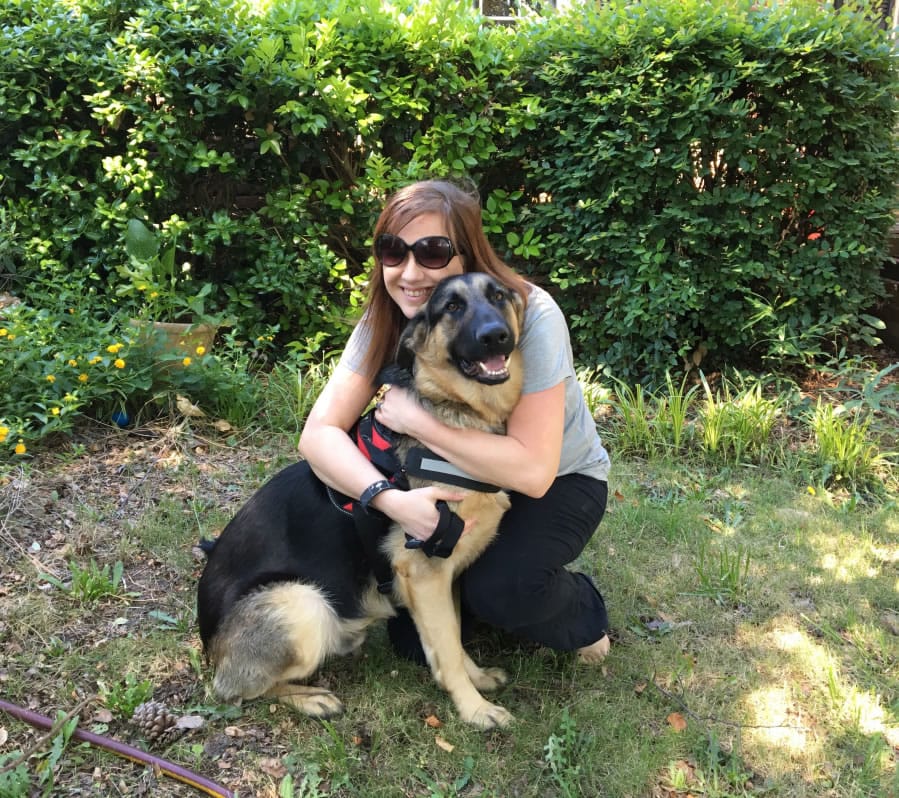Service dogs, most people probably think, are for blind people. And maybe for someone who uses a wheelchair. Not so much for those who appear hale and hearty. We don’t realize what a dog could do for someone with an invisible disability such as seizures or diabetes. Or for someone like me — someone with a psychiatric disability who would eventually find my service dog so indispensable that I took him everywhere — even to Target.
I have ADHD (attention-deficit/hyperactivity disorder), TRD (treatment-resistant depression) and GAD (generalized anxiety disorder). Because of this alphabet soup of mental illness, I also have panic attacks. An overwhelming sense of doom drops down. My heart races; my breathing hitches. I shake. The attacks often don’t end until I down a Klonopin, a heavy benzodiazepine about two steps up from Xanax.
Panic attacks in public are the scariest. As I sweat and shake for no apparent reason, I feel unsafe. I look In Need of Assistance or like That Person You Should Avoid. It would be convenient to know a panic attack is coming, so I could down some meds and remove myself and my three small children from public view.
Dogs can raise alarm
Then I found another way. After reading up on service dogs, I thought how nice it would be to have one — one who would warn me when a panic attack was about to happen, one who might even get my medication from my purse. My doctor thought it was a splendid idea. I could arrange for my own service dog pretty easily because there’s no nationwide governing body for such animals. When I looked up what I had to do to get a puppy certified, I was astounded: There is no certification. The Foundation for Service Dog Support, a nonprofit, trains golden retrievers, sells vests and certificates, and teaches people how to train their own service dogs. They say a service dog should obey commands 90 percent of the time, not steal food and ignore other dogs. But those standards have no legal standing.
The Americans With Disabilities Act stipulates that to be deemed a service dog, the animal must be trained to perform a helpful task, but the law also states that it’s illegal for anyone to require that the dog demonstrate that ability.
Basically, you can just slap a vest on a canine, stick a “service dog” patch on it and gin up an identification card at any number of online paper mills.
This makes the service-dog designation ripe for abuse by people taking their pets into no-pets-allowed public places or bringing them on airline flights for free. Brian Skewis, executive officer of the California State Board of Guide Dogs for the Blind, told the Detroit Free Press that many of the service dogs he sees in airports are used fraudulently.
“Everyone agrees there’s a problem, but there’s no clear-cut solution,” he says.
Colorado has passed a law making it illegal to misrepresent an untrained dog as a service animal, according to the Gazette of Colorado Springs. Penalties include $25 for a first offense, as much as $200 for a second offense and up to $500 for a third.
Queequeg, named after both the dog on “The X-Files” and the harpooner in “Moby-Dick,” was a tiny ball of German shepherd fuzz the first time my husband and I saw him. We picked him because he was cuddly and brought him home when he was about 9 weeks old. He had become relatively huge by about 4 months and would continue to grow until his head hit my waist and he weighed a lanky 100 pounds.
I began training him myself. That’s legal, according to Service Dog Central, a website offering information about service dogs. I knew how to train the basics of obedience: sit-stay-come, walk nicely on a leash. Queequeg picked them up quickly — all but “stay,” which we’re still working on. We took him everywhere and corrected him when he pulled.
It’s been more difficult to train him to recognize that I’m about to have a panic attack. When one is imminent, my breathing speeds up. So I used that as a signal for him to tell me that I was about to panic. To train him to recognize it, I found his favorite treat — bread — and put it in my fist. I would make myself breathe faster in these training sessions. After lots of repetitions, Queequeg learned to hit my right hand with his snout when my breathing changed.
In addition to the panic-attack hand bonk, we’re teaching him to fetch my Klonopin and sit in my lap, providing the deep pressure that helps me calm down while waiting for the medication to work.
The first time I took Queequeg out, his official-looking vest hadn’t come yet, but I had a blaze-orange coat that fit him. So, with many misgivings, we trotted off to Target. I worried they wouldn’t let me in. I worried that he would poop in the aisle. I worried that people would mob him. But mostly I worried that they’d stop me at the door.
If you walk into a place with an animal and act as if the two of you are supposed to be there, everyone accepts it. Target could have barred us: Service dogs in training, unlike regular service animals, can’t automatically go everywhere — and it’s up to the animal’s owner to decide when the service dog “graduates” because, again, there’s no formal certification.
After that first trip to Target, Queequeg’s official “In Training” vest arrived, and he went everywhere with us.
We’ll keep taking him places. We’ll keep training him. When he can alert me to a panic attack, retrieve my meds and provide deep-pressure comfort, all while acting like a canine good citizen, we’ll slap that “service dog” patch on his vest.



